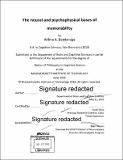| dc.contributor.advisor | Aude Oliva. | en_US |
| dc.contributor.author | Bainbridge, Wilma A | en_US |
| dc.contributor.other | Massachusetts Institute of Technology. Department of Brain and Cognitive Sciences. | en_US |
| dc.date.accessioned | 2017-01-12T18:33:07Z | |
| dc.date.available | 2017-01-12T18:33:07Z | |
| dc.date.copyright | 2016 | en_US |
| dc.date.issued | 2016 | en_US |
| dc.identifier.uri | http://hdl.handle.net/1721.1/106429 | |
| dc.description | Thesis: Ph. D., Massachusetts Institute of Technology, Department of Brain and Cognitive Sciences, 2016. | en_US |
| dc.description | Cataloged from PDF version of thesis. | en_US |
| dc.description | Includes bibliographical references (pages 177-203). | en_US |
| dc.description.abstract | Every person has a unique set of individual experiences that make up their memories. Yet surprisingly, recent work has shown that people tend to remember and forget the same images. This is because these images differ in their memorability - a predictive value of whether an image is likely to be later remembered or not. However, the properties of memorability and its effects in the brain are unexplored. Here, I describe the first characterization of the neural and psychophysical bases of memorability. First, I show that memorability is highly consistent in the domain of face images, despite their similar perceptual features and same basic-level category, and examine what facial attributes are predictive of memorability (Chapter 2). I extend these findings to demonstrate that memorability is not only consistent across images, but across different images of the same face identity (Chapter 3); thus, memorability can be conceptualized as an intrinsic property to whole entities. I then compare memorability to several phenomena shown to influence memory - bottom-up attention, top-down attention, and priming - and find that memorability effects remain independent of these phenomena (Chapter 4). Lastly, I investigate the neural correlates of memorability in a human functional magnetic resonance imaging experiment (Chapter 5). I find sensitivity to memorability in the medial temporal lobe and ventral visual stream, with a memorability-centric representational geometry in the neural patterns in these regions. Importantly, this sensitivity is dissociable from classical individual subsequent memory effects that I show to be localized in the prefrontal cortex. These results also indicate that until now, memory work has largely confounded the effects of the participant (individual memory) and the stimulus (memorability), and I propose a re-examination of past memory findings through the lens of memorability. In whole, this work presents memorability as a novel phenomenon, easily quantified for images and entities, with its own dedicated neural signatures at the intersection of perception and memory. | en_US |
| dc.description.statementofresponsibility | by Wilma A. Bainbridge. | en_US |
| dc.format.extent | 203 pages | en_US |
| dc.language.iso | eng | en_US |
| dc.publisher | Massachusetts Institute of Technology | en_US |
| dc.rights | M.I.T. theses are protected by copyright. They may be viewed from this source for any purpose, but reproduction or distribution in any format is prohibited without written permission. See provided URL for inquiries about permission. | en_US |
| dc.rights.uri | http://dspace.mit.edu/handle/1721.1/7582 | en_US |
| dc.subject | Brain and Cognitive Sciences. | en_US |
| dc.title | The neural and psychophysical bases of memorability | en_US |
| dc.type | Thesis | en_US |
| dc.description.degree | Ph. D. | en_US |
| dc.contributor.department | Massachusetts Institute of Technology. Department of Brain and Cognitive Sciences | |
| dc.identifier.oclc | 967233364 | en_US |
